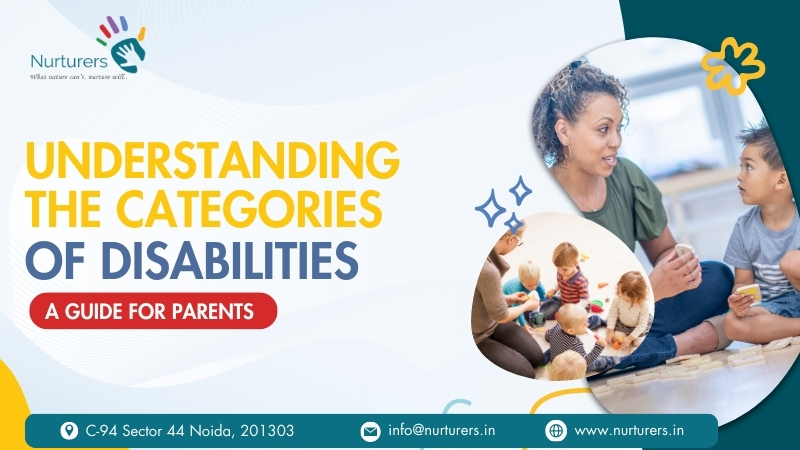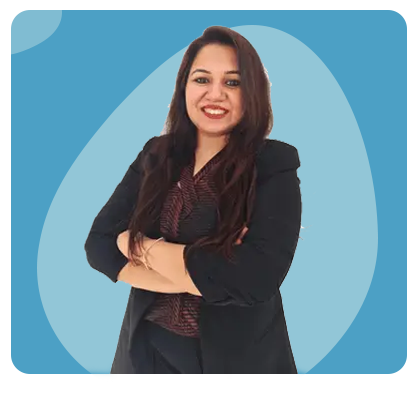Understanding the categories of disabilities in children is one of the most important steps parents can take toward supporting their child’s growth and development. A disability can impact different areas of life, such as learning, communication, movement, or social behavior. Knowing the disability meaning, the types of disability, and the causes of disability helps parents identify challenges early and seek the right interventions.
The difference between disability and disorder is also important, as many families find these terms confusing. Each category of disability—whether developmental, physical, sensory, or intellectual—affects children in unique ways, and recognizing these differences helps in planning the right approach. Knowledge about the disability percentage and the nature of challenges a child faces allows parents to better understand their strengths and needs.
Understanding Disability Meaning for Children
For children, disability meaning is more than a medical term—it reflects the challenges a child may face in everyday activities compared to others of the same age. Some children may struggle with speaking, learning in school, playing with peers, or moving their bodies smoothly. These differences do not take away from their abilities or potential; they simply point to areas where extra help is needed.
A disability often depends as much on the environment as on the child’s condition. For example, a supportive classroom, therapy sessions, and patient parenting can make a big difference in reducing barriers. With timely intervention, children can grow in independence, gain confidence, and actively participate in family, school, and community life.

Categories of Disabilities in India
India’s Rights of Persons with Disabilities (RPwD) Act, 2016 identifies and protects children across multiple Categories of Disabilities. Understanding these categories helps parents recognize their child’s needs, access therapies, and apply for disability certificates or educational accommodations.
- Physical Disabilities
These include conditions that affect a child’s body movement, posture, vision, or hearing. Examples are:
- Cerebral Palsy: Children may face challenges in controlling movement, balance, or coordination.
- Visual Impairment: Partial or complete loss of sight can impact reading, mobility, and independence.
- Hearing Loss: Children may struggle with communication, speech development, and social interaction without hearing support. With physiotherapy, assistive devices, and inclusive teaching methods, children can learn to manage daily activities effectively.
- Intellectual Disabilities
These involve difficulties in learning, communication, or reasoning. Common examples are:
- Autism Spectrum Disorder (ASD): Affects social communication, behaviour, and sensory processing.
- Down Syndrome: Associated with developmental delays and learning challenges, but children often thrive with structured support.
- Specific Learning Disabilities (SLD): Dyslexia (reading), Dysgraphia (writing), or Dyscalculia (maths), where children face difficulties despite having average or above-average intelligence. With early therapies and individualized education plans, children can achieve strong academic and social outcomes.
- Mental Behaviour (Mental Illness)
These conditions affect emotional regulation and behaviour. For children, this may include:
- Childhood Depression or Anxiety: Persistent sadness, worry, or withdrawal that affects school, play, and relationships.
- ADHD (Attention Deficit Hyperactivity Disorder): Difficulty focusing, impulsive behaviour, and restlessness that can make classroom learning challenging.
- Obsessive-Compulsive Disorder (OCD): Repeated thoughts and behaviours (like handwashing, checking, or arranging) that interfere with daily activities.
- Neurological Conditions
Long-term conditions that impact the brain or nervous system, such as:
- Epilepsy: Seizures can interrupt learning and daily routines.
- Muscular Dystrophy: Leads to progressive weakness in muscles, affecting mobility.
With medication, physiotherapy, and supportive devices, children can participate actively in school and social life.
- Blood Disorders
Chronic blood-related conditions like:
Thalassemia and Sickle Cell Anaemia: These may reduce energy levels, limit stamina, and require regular medical care. Parents should ensure regular check-ups and balanced nutrition to support growth and school participation.
- Multiple Disabilities
This refers to children who have more than one disability, such as deafblindness or a combination of physical and intellectual disabilities. These children may need comprehensive, multidisciplinary support—including therapists, special educators, and medical specialists working together.
Why this matters for parents:
Knowing which category a child falls into helps families access the right interventions—whether that means speech therapy, occupational therapy, physiotherapy, counselling, or special education. It also ensures children get legal rights under the RPwD Act, including school accommodations, scholarships, and government support.
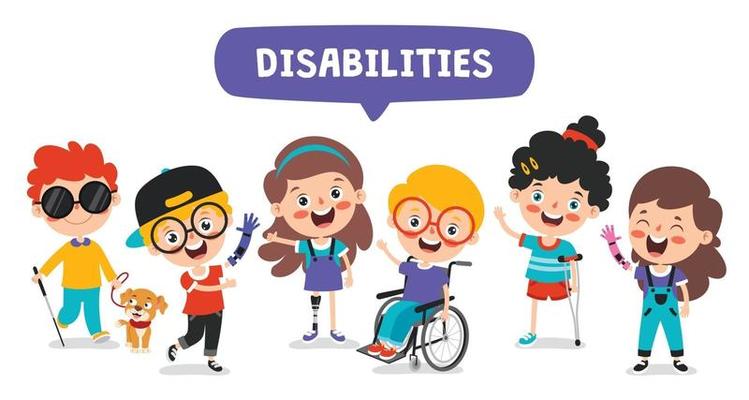
Types of disability in children
When thinking about the types of disability in children, it is important to look at how these conditions impact their day-to-day life, both at home and in school. Each type may present differently, but with the right interventions, children can learn, grow, and thrive.
- Learning Disabilities
Children with learning disabilities often have normal or above-average intelligence but may struggle with specific academic skills.
- Dyslexia: Difficulty with reading, spelling, and writing.
- Dyscalculia: Trouble understanding numbers and solving mathematical problems.
- Dysgraphia: Difficulty with handwriting and written expression. With remedial education, special teaching methods, and patience, children can overcome these challenges and succeed in academics.
- Speech and Language Disabilities
Some children may not develop speech on time or may have unclear speech. Others may find it difficult to understand or express language.
- This can affect classroom participation, social interaction, and confidence.
- Early speech therapy helps children build vocabulary, improve clarity, and develop effective communication.
- Autism Spectrum Disorder (ASD)
Autism affects the way a child communicates, interacts, and responds to the world.
- Challenges may include difficulty with social interaction, repetitive behaviours, and sensory sensitivities.
- Some children may excel in specific areas like memory, art, or problem-solving. With structured therapies like Applied Behaviour Analysis (ABA), occupational therapy, and parent training, children with autism can gain independence and social skills.
- Physical Disabilities
These affect a child’s movement, coordination, or posture. Examples include cerebral palsy, spina bifida, or muscular dystrophy.
- Physical disabilities may make activities like walking, writing, or playing difficult.
- Physiotherapy, assistive devices (wheelchairs, braces), and inclusive sports can help children stay active and independent.
- Hearing Impairment
Children with partial or complete hearing loss may face difficulties in language development, learning, and social interaction. Early use of hearing aids, cochlear implants, and sign language can significantly improve communication and academic progress. - Vision Impairment
Visual challenges may include low vision or total blindness. These can affect reading, writing, and mobility. Tools like Braille, magnifiers, screen readers, and large-print books enable children to learn effectively.
Recognising the types of disability early helps parents seek therapies like speech therapy, occupational therapy, or special education support.
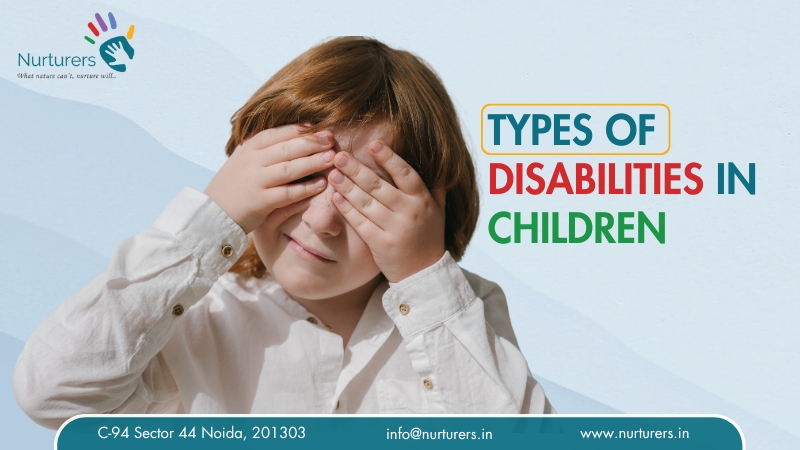
Common causes of disability in children
Childhood disabilities can arise from a variety of causes of disability, and understanding them helps parents take timely action.
- 1. Genetic or Congenital Factors
Some children are born with conditions such as Down syndrome, thalassemia, or muscular dystrophy. These are linked to genetic changes and may affect growth, learning, or physical health from birth. - 2. Developmental Factors
Challenges may arise during pregnancy, childbirth, or early growth. Examples include premature birth, birth asphyxia (lack of oxygen during delivery), low birth weight, or delayed stimulation in early years. These can impact a child’s brain and body development. - 3. Environmental Factors
Conditions outside the body, like malnutrition, severe infections, exposure to harmful toxins, accidents, or untreated illnesses, can contribute to disabilities in children. Many of these are preventable with proper healthcare and awareness. - 4. Social Barriers
Even when a child has only mild difficulties, lack of awareness, stigma, poor access to therapy, and inaccessible schools can make the disability worse. These social barriers are often more disabling than the condition itself.
Parents should remember: causes are often beyond anyone’s control, but early detection and therapy—based on the child’s specific needs and Categories of Disabilities—can greatly reduce the long-term impact.
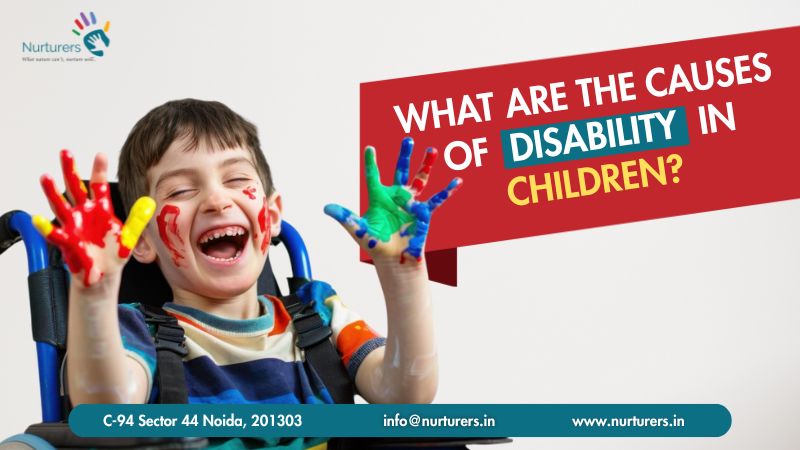
The difference between disability and disorder in children
For children, understanding the difference between a disability and a disorder is very important because it guides both diagnosis and support.
- A disorder (such as autism spectrum disorder, ADHD, or a specific learning disorder) is a clinical or medical diagnosis. It explains the underlying condition and describes patterns of behaviour, development, or functioning that are different from typical growth.
- A disability, on the other hand, describes the impact of that condition on everyday life—how it affects the child’s ability to learn in school, make friends, communicate, or manage self-care tasks.
This means:
- A child may have a disorder but, with therapies, assistive strategies, and an inclusive environment, the disability may be minimal.
- Conversely, a child with only a mild disorder may experience significant disability if there is stigma, lack of therapy, or poor school support.
This means a child may have a disorder but, with therapy and support, experience little disability. Conversely, a child with a mild disorder may face significant disability if the environment is not supportive, and this is true across different Categories of Disabilities in children.

What disability percentage means for children
In India, disability is often measured in percentage. For children, this is crucial because:
- A 40% disability percentage (or more) qualifies them as having a “benchmark disability,” which opens doors to government benefits, school accommodations, scholarships, and reservations.
- This percentage is calculated by Medical Boards using national guidelines, looking at how the child’s condition impacts daily life.
- For conditions like autism or learning disability, the assessment considers behaviour, academic performance, and developmental milestones.
Why early intervention matters for children
For children, the categories or types of disability don’t define their future. What truly matters is early support. Some key interventions include:
- Speech and Language Therapy: Supports children with delayed speech, unclear pronunciation, or difficulty in expressing themselves. Early therapy helps them develop vocabulary, clarity, and better communication skills, which are crucial for both academics and social interaction.
- Occupational Therapy (OT): Focuses on building motor skills, daily living tasks (like dressing or eating), and sensory processing. For children who are overly sensitive or under-responsive to sounds, textures, or movement, OT makes daily life smoother and more manageable.
- Special Education Support: Children with learning disabilities such as dyslexia, dysgraphia, or dyscalculia benefit from tailored teaching methods, use of assistive technology, and individualized education plans (IEPs). This helps them keep pace with school and reduces frustration.
- Behavioural Therapy: Especially important for children with autism, ADHD, or emotional challenges. It helps improve focus, manage behaviour, build social skills, and increase confidence in daily routines.
- Physiotherapy: Strengthens muscles, improves balance, and enhances mobility for children with cerebral palsy, muscular dystrophy, or other physical conditions. It also helps them take part in play and sports activities with peers.
With consistent therapies, inclusive education, and a clear understanding of the Categories of Disabilities, children with disabilities can achieve independence and thrive in academics and social life.

What parents can do now
- Watch developmental milestones and seek professional advice if delays are noticed.
- Don’t wait for a “formal label”—early therapy helps regardless of diagnosis.
- Explore the Categories of Disabilities in the RPwD Act to see where your child may fit.
- Apply for a disability certificate if your child’s challenges significantly impact learning or daily functioning—disability percentage is the key.
- Stay connected with schools and therapy centres like Nurturers, where interventions are child-focused and family-supported.
Final Note for Parents
A child’s disability does not define their potential. By understanding the meaning of disability, the Categories of Disabilities, the types of disability, the causes of disability, the difference between disability and disorder, and how disability percentage works in India, parents can make informed choices. With the right therapies, inclusive education, and love, children can grow into confident, capable individuals.
